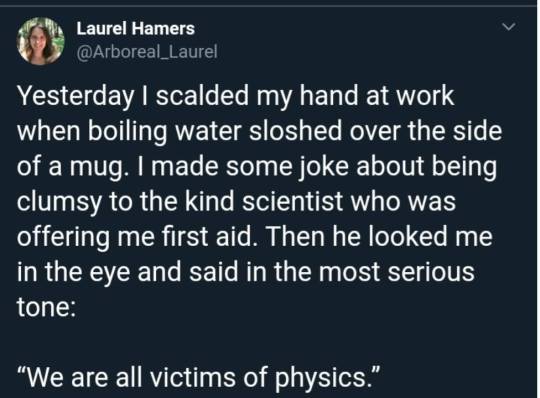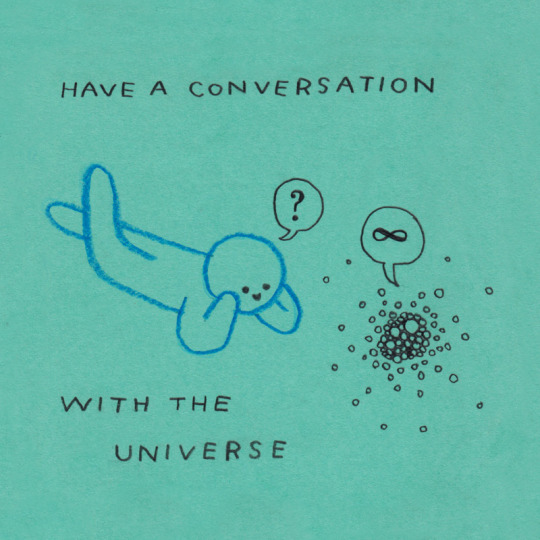Photo

Yesterday’s #NobelPrize in #Physics was awarded to researchers who provided evidence for the existence of black holes, including a supermassive black hole at the centre of our galaxy: https://ift.tt/2Sw2msh 🕳 https://ift.tt/36E11aT
417 notes
·
View notes
Text
Is the world we live in unreal or nonlocal?

Whether we have to give up locality or reality is a controversial discussed topic for the last century - yet we do not have a clear answer until today. Let’s focus on the question why we have to decide and consider the following experiment:
We got two spin-½ particles propagating in opposing directions, each going through a Stern-Gerlach magnet. After those magnets there are only two possibilities: Either the particle got spin +½ or -½. We can measure the spin in different directions α, β, γ. We’re going to see that the main point is the correlation between the states of both particles.

These two particles are to be found in a so called singlet-state [the first line in the following graphic depicts the singlet-state in Dirac-notation. The first and second position of the arrows in each ket correspond to one particle with its own Hilbert space. There are two arrows in each ket because they can be ‘combined’ via tensor product. If you are interested in more details - you can look it up in the chapter about addition of angular momentum in Griffiths’ Introduction to Quantum mechanics]. Any time we measure the spin of the particle on the right side we are going to get the exactly opposing result on the left side. This is the ‘spirit’ of the singlet state. In Addition both spins sum up to zero.

We could assume that every pair of particles got some inherent data, so called hidden variables, so that we have an a priori logical explanation for the correlation. Because each particle can only adopt two different states (spin +½ or -½) and we are looking at three different directions we can conclude the following:

What we got now is a formulation of Bell’s inequality. Using a special combination of angles α, β, γ the experiment shows: Bell’s inequality is violated. Now we have to ways to explain this damn weird situation:
Giving up reality, which means that any properties of an object are not real until they are measured. In the moment of measurement they ‘decide’ which value they adopt for a certain parameter.
Giving up locality, which means that there is some kind of ‘communication’ between the particles. This ‘communication’ has to work with superluminar velocities (due to the experimental conditions [distance of magnets]). We still have the possibility to save a kind of ‘statistical locality’ such that heavy violations of Einstein’s relativity do not occur. In addition it is important to note: entanglement can not be used to transport information faster than light.
A majority of physicists accepts way 1 which leads to Copenhagen Interpretation. In my “opinion” (as far as there can be opinions regarding objective science) way 2 is much easier to accept. In physics we have to work with superluminar velocities more often than the wider educated public thinks (e.g. phase and group velocities of waves). Claiming that particles are not real until they are measured may be broadly accepted but does not make sense to me any more. Feel free to discuss!
—
Here is a groundbreaking paper to the violation of Bell’s inequality with a EPR-like experiment.
159 notes
·
View notes
Text
How to Really Comprehend a Scientific Paper
**credit to my research advisor, she’s an amazing mentor and I aspire to be just like her someday :)
Read the abstract. Write down what the paper says it is going to be about.
Read the introduction. Write down what the paper says it is looking to accomplish and how.
Read the conclusion. Write down what the paper actually did accomplish.
Go through and find all the pictures, graphs, or diagrams. Write notes explaining these images to yourself.
Read the whole paper start to finish. Write a summary of the paper as though you are explaining it to a layperson, and then another summary as though you are explaining it to a colleague.
Throughout all of the above steps:
If there are words you don’t know google them and write down the definitions
If the paper defines a formula, law, variable, etc in a certain way write that down
If there are references to or recommendations of other literature write those down. After the last step if there’s anything you’re uncertain about or would like more information on look to that list for further reading
12K notes
·
View notes
Text

43 notes
·
View notes
Text
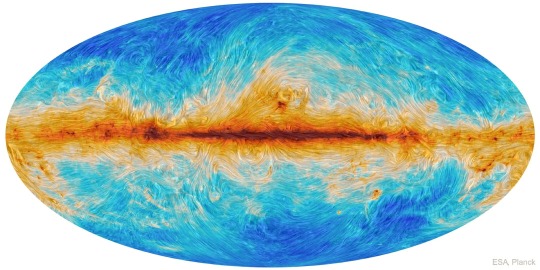
Magnetic Streamlines of the Milky Way
What role do magnetic fields play in interstellar physics? Analyses of observations by ESA's Planck satellite of emission by small magnetically-aligned dust grains reveal previously unknown magnetic field structures in our Milky Way Galaxy -- as shown by the curvy lines in the featured full-sky image. The dark red shows the plane of the Milky Way, where the concentration of dust is the highest. The huge arches above the plane are likely remnants of past explosive events from our Galaxy's core, conceptually similar to magnetic loop-like structures seen in our Sun's atmosphere. The curvy streamlines align with interstellar filaments of neutral hydrogen gas and provide tantalizing evidence that magnetic fields may supplement gravity in not only in shaping the interstellar medium, but in forming stars. How magnetism affected our Galaxy's evolution will likely remain a topic of research for years to come.
Image Copyright: Image Credit: ESA, Planck; Text: Joan Schmelz (USRA)
Time And Space
120 notes
·
View notes
Photo



In Roman Hill’s “As Above,” we see expansive celestial landscapes. Except, in reality, we are watching fluids undergoing a chemical reaction on an 8 sq mm canvas. (Video and image credit: R. Hill)
585 notes
·
View notes
Text
Universe’s coolest lab creates bizarre quantum matter in space
ISS - Cold Atom Lab (CAL) patch. 12 June 2020 Physicists have made a Bose–Einstein condensate on the International Space Station — allowing them to probe the mysteries of quantum physics in detail.
Image above: The International Space Station is home to the Cold Atom Lab — one of the coldest places in the known Universe. Image Credit: NASA. For 25 years, physicists have used an exotic state of matter made from ultracold atoms to probe quantum behaviour at the macroscopic scale. Now, they can do it in space. The feat comes from physicists behind NASA’s US$100-million Cold Atom Lab, which began operating on the International Space Station in June 2018. The results are a proof-of-principle showing that the laboratory can successfully exploit the microgravity of space in ways that should allow scientists to create phenomena that would be impossible on Earth. The facility is on track to become the coldest place in the known Universe.
A Recipe for Cooling Atoms to Almost Absolute Zero
“I think it’s just an amazing achievement,” says Courtney Lannert, a theoretical physicist at Smith College in Northampton, Massachusetts. The findings were published1 in Nature on 11 June. Exotic behaviour First created in 1995, Bose–Einstein condensates form when clouds of atoms are chilled to just above absolute zero. At this temperature, the particles’ wave-like quantum nature dominates, and they coalesce into a single macroscopic quantum object, which physicists can use to investigate exotic behaviour. On Earth, gravity limits studies on these clouds because they quickly disperse unless gravity’s effects are counteracted with strong magnetic fields. But in microgravity, the condensates last longer, allowing for more precise studies. And because weak magnetic ‘traps’ for the atoms can be used in space, physicists can chill them to even lower temperatures, in part by harnessing a technique that cools condensates by allowing them to expand. “Most quantum physicists would say cold-atom experiments are cool, but to make them cooler you have to take them to space,” says Kamal Oudrhiri, CAL mission manager at the Jet Propulsion Laboratory in Pasadena, California.
Image above: Cold Atom Lab Physics Package. Shown here, the “physics package” inside NASA’s Cold Atom Lab, where ultracold clouds of atoms called Bose-Einstein condensates are produced. Image Credits: NASA/JPL-Caltech. The researchers used CAL’s precise lasers and high vacuum to produce condensates that lived for longer than a second at 200 trillionths of a degree above absolute zero, on par with some of the most successful experiments on Earth. In future experiments, the team plans to go down to a record 20 trillionths of a degree and create condensates that last for 5 seconds, says Oudrhiri. That would make it the coldest place in the known Universe. Dishwasher-sized lab The condensate isn’t the first produced in space. Experiments on rockets that temporarily cross the barrier into space — as well as those using drop towers on Earth — have provided indications of how this phase of matter behaves in microgravity. But CAL is the first lab of its kind to exist in this environment permanently, says Maren Mossman, a physicist at Washington State University in Pullman, and could be just the first of a series of space-based cold-atom labs. Its success was not a given, she says; CAL puts kit that typically fills an entire lab into a space the size of a dishwasher. And these are just the first results to come from the lab. Mossman is part of a team that is using CAL to create Efimov states, groups of particles that bind in threes but not twos and have long fascinated physicists.
What’s So Cool About NASA’s Cold Atom Lab?
Other teams have also started experiments to create phenomena possible only in the ISS environment. Lannert’s team, for example, has begun producing 30-micrometre-wide bubbles of condensate. Under Earth’s gravity, these would collect to form a bowl or pancake shape. The features of bubbles — being thin and edgeless — mean that they should create whirlpools, known as vortices, with novel behaviours, she says. “The shape is not possible unless you remove the force of gravity. So far, it’s looking really good in terms of the trap doing what we expect it to do.” ‘Heart surgery’ in space Already the most complex experiment ever on the ISS, the facility got a mind-bending upgrade in January. Over eight days, NASA astronauts Christina Koch and Jessica Meir installed an atom interferometer, a process Oudrhiri likens to performing heart surgery in space. The interferometer splits a cloud into two quantum states — with each atom effectively existing in two places at once — before reuniting them to produce an interference pattern. This pattern acts as a sensitive gauge of forces around the condensate, which physicists can use to test fundamental laws of nature or to search for dark energy. Tests in May — when the coronavirus lockdown meant that the remotely operated CAL was the United States’ only operational cold-atom lab — show that the atom interferometer is working as planned, says Oudrhiri.
Animation above: This artist’s illustration shows six finely tuned lasers being used to slow down atoms inside NASA’s Cold Atom Lab, which chills atoms to almost absolute zero. Animation Credits: NASA/JPL-Caltech. The compact nature of CAL meant that compromises had to be made in its abilities, and it is not ideal for every experiment because it suits the needs of multiple projects, says Lannert. “But the trade-off is more than worth it,” she adds. It also allows physicists without their own extensive labs to perform these experiments. “We’re at a small liberal-arts college, and being able to take data on this machine is just super exciting.” NATURE: doi: 10.1038/d41586-020-01773-z Related links: Bose–Einstein condensates: https://www.nature.com/news/2010/101124/full/news.2010.630.html Cold Atom Lab (CAL): https://www.jpl.nasa.gov/missions/cold-atom-laboratory-cal/ Space Station Research and Technology: https://www.nasa.gov/mission_pages/station/research/overview.html International Space Station (ISS): https://www.nasa.gov/mission_pages/station/main/index.html Text, Image, Videos, Animation (mentioned), Credits: NATURE/Elizabeth Gibney/NASA/JPL-Caltech. Greetings, Orbiter.ch Full article
43 notes
·
View notes
Text
May the Four Forces Be With You!
May the force be with you? Much to learn you still have, padawan. In our universe it would be more appropriate to say, “May the four forces be with you.”
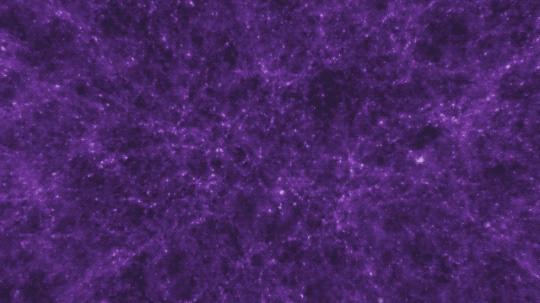
There are four fundamental forces that bind our universe and its building blocks together. Two of them are easy to spot — gravity keeps your feet on the ground while electromagnetism keeps your devices running. The other two are a little harder to see directly in everyday life, but without them, our universe would look a lot different!
Let’s explore these forces in a little more detail.
Gravity: Bringing the universe together
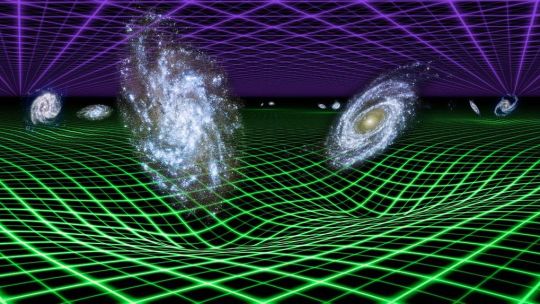
If you jump up, gravity brings you back down to Earth. It also keeps the solar system together … and our galaxy, and our local group of galaxies and our supercluster of galaxies.
Gravity pulls everything together. Everything, from the bright centers of the universe to the planets farthest from them. In fact, you (yes, you!) even exert a gravitational force on a galaxy far, far away. A tiny gravitational force, but a force nonetheless.
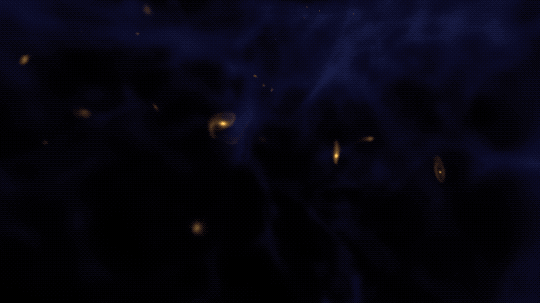
Credit: NASA and the Advanced Visualization Laboratory at the National Center for Supercomputing and B. O'Shea, M. Norman
Despite its well-known reputation, gravity is actually the weakest of the four forces. Its strength increases with the mass of the two objects involved. And its range is infinite, but the strength drops off as the square of the distance. If you and a friend measured your gravitational tug on each other and then doubled the distance between you, your new gravitational attraction would just be a quarter of what it was. So, you have to be really close together, or really big, or both, to exert a lot of gravity.
Even so, because its range is infinite, gravity is responsible for the formation of the largest structures in our universe! Planetary systems, galaxies and clusters of galaxies all formed because gravity brought them together.
Gravity truly surrounds us and binds us together.
Electromagnetism: Lighting the way
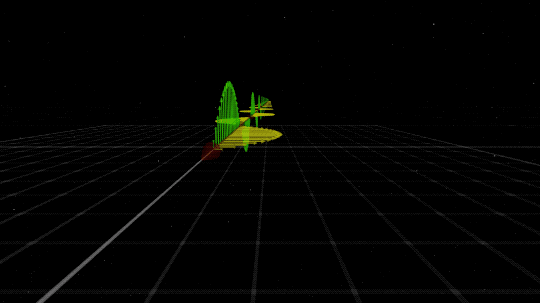
You know that shock you get on a dry day after shuffling across the carpet? The electricity that powers your television? The light that illuminates your room on a dark night? Those are all the work of electromagnetism. As the name implies, electromagnetism is the force that includes both electricity and magnetism.
Electromagnetism keeps electrons orbiting the nucleus at the center of atoms and allows chemical compounds to form (you know, the stuff that makes up us and everything around us). Electromagnetic waves are also known as light. Once started, an electromagnetic wave will travel at the speed of light until it interacts with something (like your eye) — so it will be there to light up the dark places.

Like gravity, electromagnetism works at infinite distances. And, also like gravity, the electromagnetic force between two objects falls as the square of their distance. However, unlike gravity, electromagnetism doesn’t just attract. Whether it attracts or repels depends on the electric charge of the objects involved. Two negative charges or two positive charges repel each other; one of each, and they attract each other. Plus. Minus. A balance.
This is what happens with common household magnets. If you hold them with the same “poles” together, they resist each other. On the other hand, if you hold a magnet with opposite poles together — snap! — they’ll attract each other.
Electromagnetism might just explain the relationship between a certain scruffy-looking nerf-herder and a princess.
Strong Force: Building the building blocks
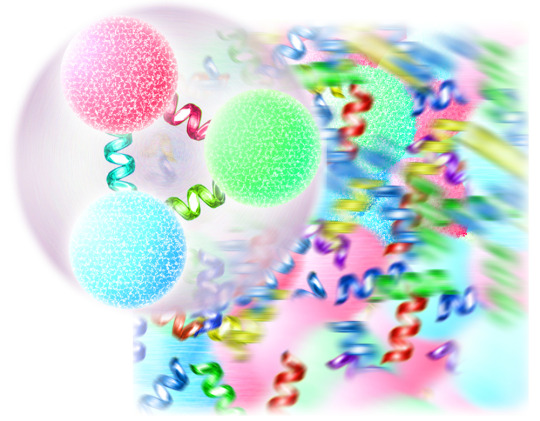
Credit: Lawrence Livermore National Laboratory
The strong force is where things get really small. So small, that you can’t see it at work directly. But don’t let your eyes deceive you. Despite acting only on short distances, the strong force holds together the building blocks of the atoms, which are, in turn, the building blocks of everything we see around us.
Like gravity, the strong force always attracts, but that’s really where their similarities end. As the name implies, the force is strong with the strong force. It is the strongest of the four forces. It brings together protons and neutrons to form the nucleus of atoms — it has to be stronger than electromagnetism to do it, since all those protons are positively charged. But not only that, the strong force holds together the quarks — even tinier particles — to form those very protons and neutrons.
However, the strong force only works on very, very, very small distances. How small? About the scale of a medium-sized atom’s nucleus. For those of you who like the numbers, that’s about 10-15 meters, or 0.000000000000001 meters. That’s about a hundred billion times smaller than the width of a human hair! Whew.
Its tiny scale is why you don’t directly see the strong force in your day-to-day life. Judge a force by its physical size, do you?
Weak Force: Keeping us in sunshine

If you thought it was hard to see the strong force, the weak force works on even smaller scales — 1,000 times smaller. But it, too, is extremely important for life as we know it. In fact, the weak force plays a key role in keeping our Sun shining.
But what does the weak force do? Well … that requires getting a little into the weeds of particle physics. Here goes nothing! We mentioned quarks earlier — these are tiny particles that, among other things, make up protons and neutrons. There are six types of quarks, but the two that make up protons and neutrons are called up and down quarks. The weak force changes one quark type into another. This causes neutrons to decay into protons (or the other way around) while releasing electrons and ghostly particles called neutrinos.
So for example, the weak force can turn a down quark in a neutron into an up quark, which will turn that neutron into a proton. If that neutron is in an atom’s nucleus, the electric charge of the nucleus changes. That tiny change turns the atom into a different element! Such reactions are happening all the time in our Sun, giving it the energy to shine.
The weak force might just help to keep you in the (sun)light.
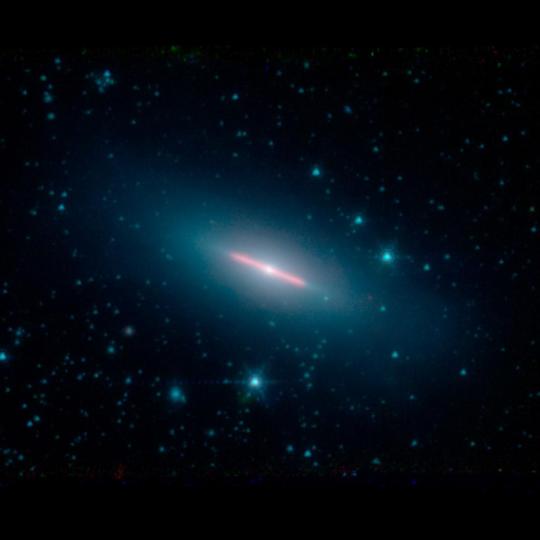
All four of these forces run strong in the universe. They flow between all things and keep our universe in balance. Without them, we’d be doomed. But these forces will be with you. Always.
You can learn more about gravity from NASA’s Space Place and follow NASAUniverse on Twitter or Facebook to learn about some of the cool cosmic objects we study with light.
Make sure to follow us on Tumblr for your regular dose of space: http://nasa.tumblr.com
6K notes
·
View notes
Text
I saw the Kurzgesagt video about why we are life and now “becoming one with the universe” has become a more morbid phrase and I’m freaking out about it.
0 notes
Text


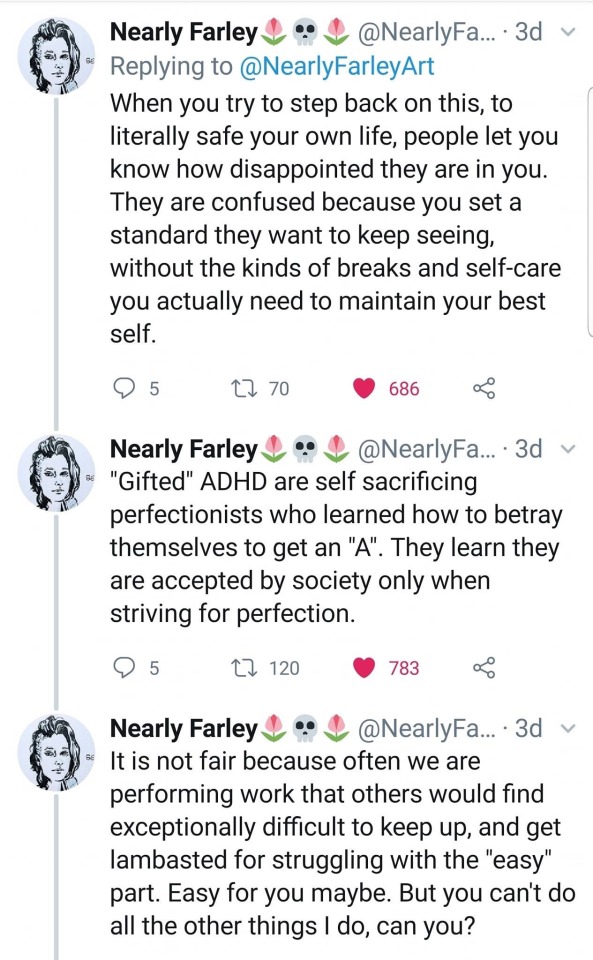


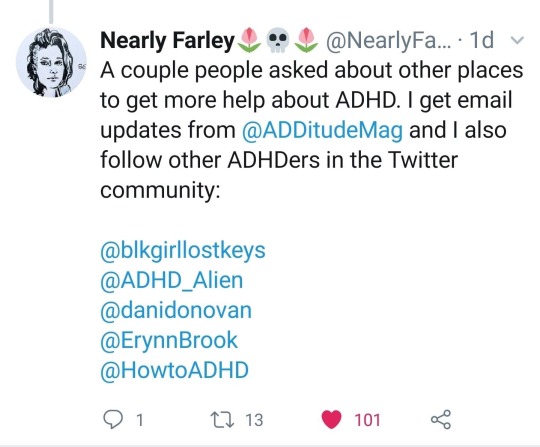
25K notes
·
View notes
Text
Cool Tip
If you are like me and always need to be working on something to keep your anxiety under control, during this quarentine why not helping scientists by looking at pictures of some neat penguins? or even galaxies? There’s this site call Zooniverse, where you can help on scientific projects by analyzing pictures and data! Right now my favorite project has returned, called Penguin Watch (where yeah, you get to watch penguins, it’s amazing)
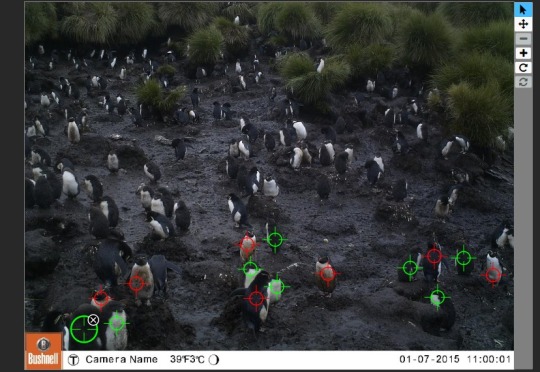
you basically have to analyse photos looking for penguins, their chicks, eggs or even predators and human interaction But there are lots of interesting projects you can help in areas such as biology, physics, history or even art:
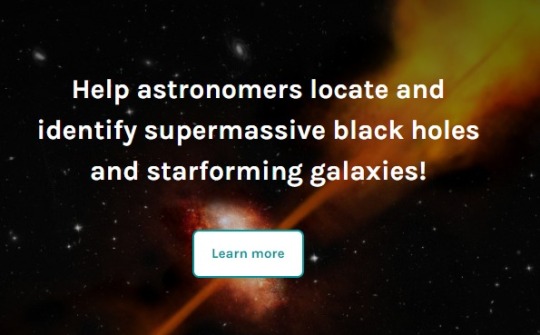


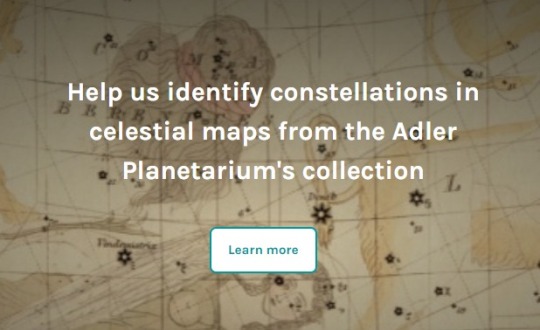


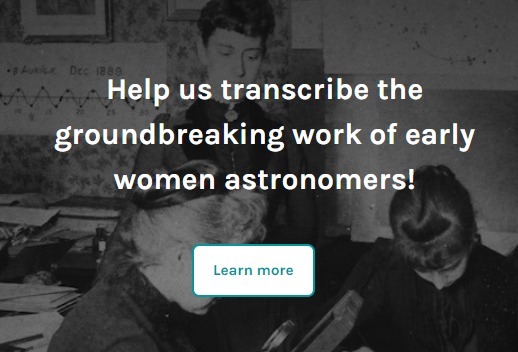

Oh and the best part, some institutions even accept it as volunteering/service hour requirements for graduation and scholarships!! It’s helping me a lot during this time, so I thought it was worth sharing
91K notes
·
View notes
Text
Mikrowellen sind schon irgendwie hertzerwärmend.
500 notes
·
View notes
